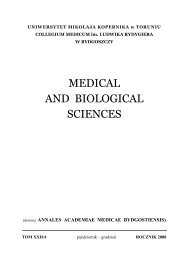Wsparcie spoÅeczne u chorych z miażdżycÄ tÄtnic koÅczyn dolnych
Wsparcie spoÅeczne u chorych z miażdżycÄ tÄtnic koÅczyn dolnych
Wsparcie spoÅeczne u chorych z miażdżycÄ tÄtnic koÅczyn dolnych
You also want an ePaper? Increase the reach of your titles
YUMPU automatically turns print PDFs into web optimized ePapers that Google loves.
The effect of mild hyperthermia on morphology, ultrastructure and F-actin organization in HL-60 cell line 23<br />
The effect of mild hyperthermia on F-actin<br />
organization<br />
Alexa Fluor 488-phalloidin staining was applied for<br />
visualization of changes in filamentous actin<br />
organization after treatment of HL-60 cells with mild<br />
hyperthermia. Control HL-60 cells displayed a spread<br />
F-actin cytoskeleton with well-defined peripheral<br />
limits and intact nuclei. Only a few nuclei were<br />
morphologically changed (Fig. 4A,A').<br />
dense cortical F-actin ring as well as the appearance of<br />
bright F-actin clusters and network scattered<br />
throughout the cytoplasm (Fig. 4C,D). Moreover,<br />
directly after heating, the cells with fragmented nuclei<br />
and degradation of the F-actin cytoskeleton were often<br />
observed (Fig. 4B,B'). These alterations were also<br />
noticed following a recovery time of 3 and 6 hrs (Fig.<br />
4C,C',D,D'). After the recovery period, actin filaments<br />
were arranged circumferentially in dense, ring-like<br />
structures or in the form of densifications or<br />
aggregations under the plasma membrane (Fig. 4D).<br />
Furthermore, F-actin became organized in dots and<br />
networks scattered throughout the cytoplasm (Fig. 4C).<br />
Fig. 4. The effect of mild hyperthermia on the F-actin<br />
organization in the HL-60 cells; F-actin was stained<br />
with Alexa Fluor 488 phalloidin, nuclei were<br />
counterstained with DAPI; Non-treated cells (A,A');<br />
The HL-60 cells were heat shocked at 40ºC for 2 hrs<br />
(B,B') and returned to 37ºC for: 3 hrs (C,C') or 6 hrs<br />
(D,D')<br />
Ryc. 4. Wpływ łagodnej hipertermii na organizację F-aktyny<br />
w komórkach linii HL-60; F-aktynę wyznakowano<br />
falloidyną skoniugowaną z Alexa Fluor 488, jądra<br />
wybarwiono DAPI; Komórki kontrolne (A,A');<br />
Komórki HL-60 poddano szokowi cieplnemu w<br />
temperaturze 40ºC przez 2h (B,B'), po czym<br />
ponownie umieszczono w 37ºC na okres 3 (C,C') lub<br />
6h (D,D')<br />
The structural remodeling of actin was observed<br />
immediately after heat shock treatment but was more<br />
evident 3 and 6 hrs after the exposure. These effects<br />
were reflected mainly by a higher definition of the<br />
Discussion<br />
Hyperthermia is a type of medical therapy in<br />
which body tissues are exposed to slightly<br />
higher temperatures to damage or make cancer cells<br />
more sensitive to other chemical or physical factors.<br />
Heat-shock destroys enzyme complexes present in the<br />
cytoplasm and mitochondria membrane but also causes<br />
alterations in enzyme system cycles, which is involved<br />
with changes in chromatin organization, regulation of<br />
gene expression and ion homeostasis [12, 15]. Our<br />
previous studies showed the effect of 41 and 44.5ºC on<br />
the morphology, ultrastructure and actin cytoskeleton<br />
of CHO AA8 cells [16, 17]. We also investigated the<br />
influence of hyperthermia (43.5 and 45ºC) on H1299<br />
lung cancer cells [18]. In our studies, we noticed shape<br />
changes and characteristic, apoptotic features in heattreated<br />
CHO AA8 and H1299 cells [16-18].<br />
Furthermore, H1299 cells treated with 43.5 and 45°C<br />
heat stress showed similar changes in cell shape and<br />
membrane structure, which were probably the<br />
consequence of loss or reduction of integrins at the cell<br />
surface [18]. Hyperthermia also induces changes in<br />
actin organization, especially in switching from<br />
filamentous to monomeric state [19]. In CHO AA8 and<br />
H1299 reorganization of actin cytoskeleton was also<br />
observed [16-18]. In this paper, analyses were<br />
performed using a non-adherent human promyelocytic<br />
leukemia cell line (HL-60) and, as previously, we<br />
observed changes in the morphology and ultrastructure<br />
after heat shock treatment. It is known that mild<br />
hyperthermia promotes cell viability and proliferation<br />
[20]. In this study, we did not find any differences in<br />
viability between the control and heat-shocked cells.<br />
Following a recovery period of 3 and 6 hrs, a slight<br />
reduction in cell viability was noticed, but these data<br />
were statistically insignificant. 3 and 6 hrs after

















